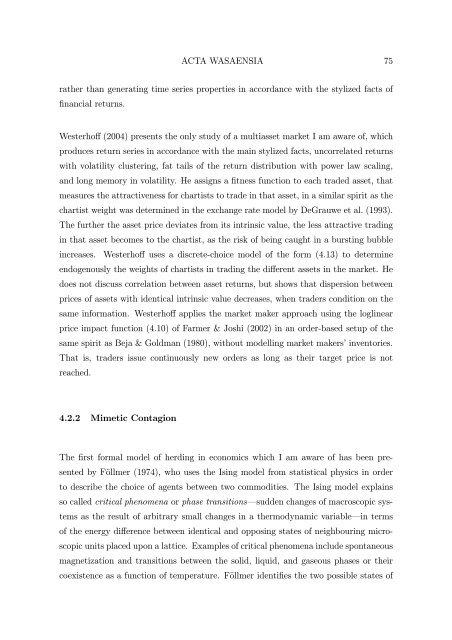BERND PAPE Asset Allocation, Multivariate Position Based Trading ...
BERND PAPE Asset Allocation, Multivariate Position Based Trading ...
BERND PAPE Asset Allocation, Multivariate Position Based Trading ...
You also want an ePaper? Increase the reach of your titles
YUMPU automatically turns print PDFs into web optimized ePapers that Google loves.
ACTA WASAENSIA 75rather than generating time series properties in accordance with the stylized facts offinancial returns.Westerhoff (2004) presents the only study of a multiasset market I am aware of, whichproduces return series in accordance with the main stylized facts, uncorrelated returnswith volatility clustering, fat tails of the return distribution with power law scaling,and long memory in volatility. He assigns a fitness function to each traded asset, thatmeasures the attractiveness for chartists to trade in that asset, in a similar spirit as thechartist weight was determined in the exchange rate model by DeGrauwe et al. (1993).The further the asset price deviates from its intrinsic value, the less attractive tradingin that asset becomes to the chartist, as the risk of being caught in a bursting bubbleincreases. Westerhoff uses a discrete-choice model of the form (4.13) to determineendogenously the weights of chartists in trading the different assets in the market. Hedoes not discuss correlation between asset returns, but shows that dispersion betweenprices of assets with identical intrinsic value decreases, when traders condition on thesame information. Westerhoff applies the market maker approach using the loglinearpriceimpactfunction(4.10)ofFarmer&Joshi (2002) in an order-based setup of thesame spirit as Beja & Goldman (1980), without modelling market makers’ inventories.That is, traders issue continuously new orders as long as their target price is notreached.4.2.2 Mimetic ContagionThe first formal model of herding in economics which I am aware of has been presentedby Föllmer (1974), who uses the Ising model from statistical physics in orderto describe the choice of agents between two commodities. The Ising model explainsso called critical phenomena or phase transitions–sudden changes of macroscopic systemsas the result of arbitrary small changes in a thermodynamic variable–in termsof the energy difference between identical and opposing states of neighbouring microscopicunits placed upon a lattice. Examples of critical phenomena include spontaneousmagnetization and transitions between the solid, liquid, and gaseous phases or theircoexistence as a function of temperature. Föllmer identifies the two possible states of
















